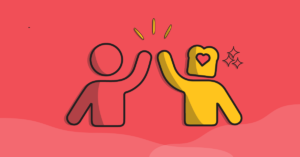
Nothing displays the uniqueness, distinctiveness and singularity of your brand position more directly than your homepage. So why do so many homepages look like every other homepage?
Actually, the answer is simple. Everyone is copying each other. Competitive emulation is the new norm.
Let’s start with a simple category such as food delivery. I picked this category because it’s broad. I typed “food delivery” into Google, and pulled up the top three results:
I purposely striped out the branding and the navigation. Why? Because customers are brand-blind, until they have a reason not to be.
To prove this point to clients, I put up an image of their homepage, stripped of the logo and nav, alongside their top three competitors. In the majority of cases, clients can’t pick out their own homepage.
If a company can’t pick out their own homepage from a crowd, what chance does a customer have? If you’re only hope is that you have enough content, money and SEO juice to rank highest, you’re screwed.
I get the trend in copying features that has been ignited by Facebook. This is not that. Your homepage is not a feature. It’s the uniqueness that is you.
New customers are brand-agnostic. They don’t care about you. So you need to give them a reason to care.
In this food delivery scenario, it’s a race to the bottom. All of the companies are basically telling the customer to look for the cheapest delivery service they can find, because they all do the same thing. Deliver food, fast, from nearby restaurants. Okay then, brand X: now what?
I can pretty much tell how this is going to shake out. You’re going to lose to Uber. Their distribution network is bigger than yours. And if all the customer cares about is speed, game over.
Next comes the niche players: vegan-only delivery service, Kosher-friendly, exclusively BBQ… and on and on and on.
I haven’t spoken to any of these companies, and I want them to know it’s not personal. I simply picked them at random. I’m sure they would tell me all about what makes them unique and special.
My only reply would be “then show me, and show the world. Stop being afraid to be different.”
What they are actually afraid of is saying “no” to someone.
Recommendation:
First, stop focusing on speed and accuracy of the order because those are category expectations. Instead, one idea could be to ask your customers about their nutritional or consumption behavior, or what they are trying to achieve:
For example:
Trying to get beach ready for Spring?
Doing Paleo? Need high protein, low fat options?
Need lunch that’s not going to give you bad breath?
Starving and need to eat during a meeting?
Need something to eat that’s not to noisy and smelly?
Only eat cage-free and dolphin-safe?
Put yourself in their office. In the area where they are consuming your product. And yes, the food is as much the product as is your web and mobile experience.
Once you are a truly unique brand, with a disruptive position, you are saying “yes” to some and “no” to others. It’s the “no” part that startups struggle with. And because of that, they become beige, blend in, and play it safe.
Define your top three to five unique brand attributes, and force rank them. The top one and two attributes will help inform the position, message and experience of the homepage.
Good companies fail because they are investing in the short term, and trying to please to many different personas.
The scenario I’m describing is difficult, and requires long-term thinking. Play this forward in terms of multiple horizons, and you’ll bury your competitors.
***If you found value, please Like, Comment and Share.